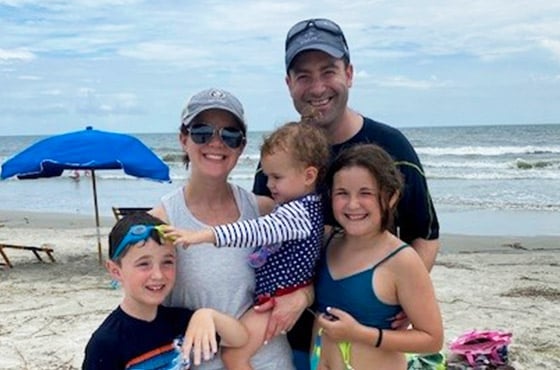
Shady Grove Fertility first introduced the Shared Risk program in 1993 with a simple guarantee: receive up to 6 in vitro fertilization (IVF) cycles for a fixed cost with the goal of welcoming home a baby, or receive a 100% refund. You may withdraw from the program at any time during treatment and receive a refund. (Note: Some exclusions may apply, please talk with your financial counselor to learn more.) In 2015 alone, over 1,300 couples enrolled in the Shared Risk program.
Today, about 82 percent of our Shared Risk 100% Refund Program participants will go on to take home a baby.
We actually created our Shared Risk 100% Refund Program for IVF in response to a patient’s tearful frustration. She told us that, after having paid for an unsuccessful IVF cycle elsewhere, another failed attempt would financially devastate her and her husband and preclude them from then adopting a baby. They could not risk gambling their adoption money on the possibility of another unsuccessful IVF cycle. Therefore, they were not going to try again using the traditional fee-for-service option despite good odds of success. Our response was to develop an innovative refund option for qualifying patients.
Over the years, many patients have thought the program was too good to be true, but with 10,000 new families and counting, the program continues to grow and provide men and women with a financial safety net when considering fertility treatment.
Am I eligible for the Shared Risk 100% Refund Program?
The Shared Risk 100% Refund Program is available for patients either through our autologous program, meaning the female partner will be using her own eggs, or our Donor Egg Program, for those women using donor eggs. Each of these treatment options has its own set of eligibility criteria. We estimate that nearly 70 percent of patients in our practice who are using their own eggs would meet the qualifications for the Shared Risk 100% Refund Program.
If you are an international or out-of-state patient, you may also participate in these programs. Depending on your situation, we can make arrangements to coordinate your care with your local physician or fertility center. Typically, we only require patients to come to our centers at a few critical points during your cycle.
What fees are covered in the Shared Risk 100% Refund Program?
The Shared Risk 100% Refund Program includes:
- All medical and laboratory services for up to 6 complete IVF cycles — from the start of medications through the first blood pregnancy test — are included. This includes assisted hatching of embryos and ICSI, if clinically needed.
- If using an egg donor, the costs of monitoring, completed at SGF, and egg retrieval are also included.
- Cryopreservation of viable embryos not transferred during any fresh Shared Risk cycle as well as the costs of FETs, until you have a baby or choose to withdraw from the program.
Shared Risk costs do not cover consultations, diagnostic testing, outside services, medications, urologic male sperm retrieval procedure, or costs associated with complications or non-IVF care.
What is ICSI?
Your doctor may recommend ICSI as part of your IVF procedure to treat many causes of infertility, especially when there is a problem with the sperm, such as low motility (movement) or a low sperm count.
ICSI is especially useful in cases where the sperm cannot penetrate the egg, or if the sperm are abnormally shaped. It is a process in which an embryologist (a specialist in egg fertilization) injects a single sperm into the cytoplasm (center) of each egg. ICSI is commonly used in cases of male factor infertility and/or diminished egg quality.
What is pre-implantation genetic testing for aneuploidies (PGT-A)?
Previously known as preimplantation genetic screening (PGS), PGT-A is a state-of-the-art procedure used in conjunction with IVF that looks for chromosomal abnormalities which may lead to miscarriage or genetic disorders. Embryos found to be chromosomally abnormal can interfere with embryo implantation, result in pregnancy loss, or in the birth of a child with physical problems, a developmental delay, or a developmental disability.
PGT-A improves the likelihood of a successful pregnancy and birth for two distinctly different groups of patients: couples with infertility related to recurrent miscarriage or previously unsuccessful IVF cycles and couples who are at risk for chromosomally abnormal embryos. Your physician may recommend PGT-A when there is a possibility, indicated by your medical history or advanced maternal age, that your embryos could be affected by a chromosomal abnormality.
Shared Risk 100% Refund Program for Frozen Embryo Transfers (FETs)
The Shared Risk 100% Refund Program for Frozen Embryo Transfers is open to couples with remaining frozen embryos from a previous fresh treatment cycle. Many of the patients who participate in this program will have frozen embryos as a result of a previous fresh IVF cycle covered by their insurance, that was paid out-of-pocket, or from a completed Shared Risk 100% Refund Program.
For a flat fee, this program, similar to the Shared Risk 100% Refund Program for IVF or Donor Egg, allows approved patients unlimited FET treatment cycles while in the program, for as many frozen embryos as that patient may have available at the time she enters the program.
In terms of program completion, a patient has the following possible outcomes: she will have a successful pregnancy and delivery; she will withdraw from the program at any time and receive a full refund; or she will use all of the embryos that are available without conceiving and receive a full refund as well.
Shared Risk 100% Refund Program vs. the Multi-Cycle Discount Program
Some patients contemplating the Shared Risk 100% Refund Program may also consider our Multi-Cycle Discount Program for IVF. In Shady Grove Fertility’s Multi-Cycle Discount Program, the patient pays one flat fee that includes all cycle monitoring, up to two fresh in vitro fertilization (IVF) cycles, cryopreservation, the first year of embryo storage, and unlimited FETs.
There are two main differences between these two programs. The first difference is when SGF considers the cycle complete. In the Multi-Cycle Discount Program, SGF considers the cycle complete when the patient reaches the egg retrieval. In our Multi-Cycle Discount Program, if no embryos result (due to a lack of fertilization), the patient will not get the opportunity to repeat the cycle; whereas in the Shared Risk 100% Refund Program, we consider the cycle complete at the point of embryo transfer. Should a patient have her eggs retrieved and have nothing to transfer (as a result of poor or no fertilization), she will get to repeat the cycle again.
The second difference is the guarantee. The Multi-Cycle Discount Program may make sense for patients who do not meet the qualifications for the Shared Risk 100% Refund Program; however, it is important to understand that the Multi-Cycle Discount Program does not offer a guarantee of outcome in the form of taking home a baby or a 100 percent refund.
If you have questions regarding the Shared Risk 100% Refund Program or would like to schedule a new patient appointment, please call our New Patient Center at 877-971-7755 or click to schedule an appointment.
Editors Note: This post was originally published in September 2015 and has been updated for accuracy and comprehensiveness as of May 2016.





